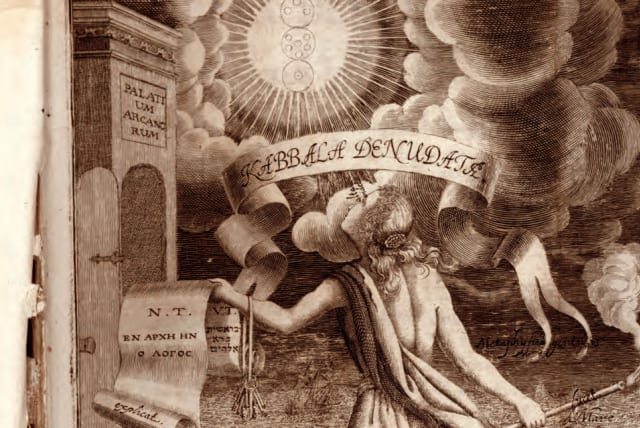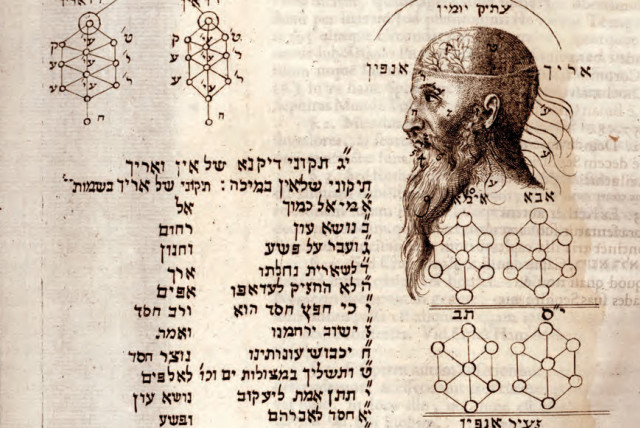'The Kabbalistic Tree': Exploring a unique dimension of Jewish thought - review

It is a comprehensive history and development of these trees, which includes multiple examples that the author has collected to illustrate his subject.
Human curiosity about the unknown knows no limit. We all want to know what happens to us after we take leave of our mortal coil. We are intrigued, if not perplexed, by the existence, or non-existence, of God. The Talmud has a phrase for unresolved questions: Teuvta hoo teuvta. “This question is unanswerable.” This has not stopped us asking the questions.
According to our tradition, the patriarch Abraham not only introduced monotheism into the world’s culture, but he also proposed a concept of an “Invisible Deity.” Abraham’s God was beyond anything that the ancient world could imagine. As opposed to idolatry or paganism, Abraham’s God could not be bribed nor inveigled to do something against His will. God was all powerful but simultaneously so totally humble as to be off the chart of human intelligence.
How then was an individual supposed to relate to God? Here the Torah – which was the living God’s words to mankind – offers the key. Throughout this sacred text, there are powerful hints that God acts in certain ways and that these ways may be replicated in our own lives in order to make sacred our otherwise profane existence.
The Jewish tradition, however, had a problem with visualizing the invisible that would make this paradox clearer. One of the Ten Commandments appears to forbid “making a graven image.” This was aimed mainly at the idolatrous practice of the time, but it was taken more generally as a ban on any visual expression of either the divine or the material world (although some exceptions were made as can be seen in wonderful mosaics in some early synagogues). Hence, all suggestions of what constituted the divine way had to be verbalized, which is what the tradition of the oral law (Torah shel be’al peh), as well as the written law (Torah shel bichtav), does in spades.
Even this did not satisfy everyone, and some 700 years ago a new concept took hold of the Jewish rabbinical tradition (although according to some traditions, its origins were primordial). It was called Kabbalah. This literally means “receiving,” indicating that there was an ongoing tradition which was received by the rabbinic elite who, in turn, could share it with a select few acolytes. Along with the esoteric meanings that this offered, exponents of Kabbalah also created a graphic concept of a tree as a symbol of the divine-in-the-world.

This tree is sometimes referred to the ilan sefirot, or the Kabbalistic tree, and is the subject of a new study by Prof. J. H. Chajes of the University of Haifa’s Department of Jewish Thought. It is a comprehensive history and development of these trees, which includes multiple examples that the author has collected to illustrate his subject. It is a fascinating in-depth look at this unique dimension of Jewish thought.
Exploring the mysteries and knowledge of Kabbalah
According to the major scholars of the subject, Kabbalah, as described in Sefer Zohar, came into being in the 12th and 13th centuries. It was an attempt to define the indefinable –what it called the Ein Sof, the no-end or infinite, symbolizing the presence of God. God’s immanence could be intuited through sefirot. This Hebrew word contains a number of associations – from story, to a thing written, to sapphire, and also sphere. In Kabbalistic circles, these sefirot could be graphically depicted as so much fruit hanging on a tree, hence the idea of a seforitic tree. The different fruits were the visible aspects of the divine, just as the tree’s roots were below ground, out of sight, representing the hidden aspect of God, the Ein Sof. The aim of the tree was not only to distinguish the visible from that which was not visible, but it was also to share the experience of the divine – as if you were confronting God face to face. You couldn’t see Him, but you could experience His presence.
It took some time for this tree to take its ultimate shape; however, it eventually become a standard structure. The sefirot number a total of 10. Beginning from the top of the tree, they are the following: keter (crown ), or chochma (wisdom); bina (understanding, or explication); da’at (applied knowledge); hessed (love or compassion): gevurah (strength or power); tiferet (beauty); netzach (endurance); hod (majesty); yesod (foundation); malchut (majesty). The two first sefirot are often used interchangeably, hence they can count as one. The main purpose of these different dimensions of the divine is that they can be shared by God and humankind, so that if the individual wants to be imitatio dei, he or she has to replicate these characteristics in his/her daily life. Typically, these sefirot were depicted graphically, often with commentary written around them. These trees were often many pages long. Paradoxically, these trees also show the limits of human capabilities.
Although the major influence on the study of Kabbalah was the Zohar, written in the 12th-13th century, the development of these mystical meditations went through a major change with Rabbi Isaac Luria, the Ari (lion) of Safed (1534- 1572). He taught a far more complex system of sefirot and all that was connected to them. His teachings became the new standard of the dissemination of Kabbalah, which also became the new wave of Kabbalah trees.
At this point, it is interesting to note the Christian interest in Kabbalah generally and in these graphic representations specifically. This interest was shared by such geniuses as Isaac Newton (1642–1727), who was at this time exploring the potential scientific contribution that Kabbalah might make to his own enterprise. A contemporary figure, Christian Knorr von Rosenroth (1636–1689), became significant not only for Christians but also for Jews. As Chajes puts it:
“A staunch Lutheran, Knorr was the leading figure of the second wave of Christian interest in Kabbalah... He pursued his studies without the Christological readings and conversionist agendas of earlier generations of Christian kabbalists. His book Kabbalah Denudata (Kabbalah unveiled) provided Christians with the tools and the texts Knorr thought necessary to embark on the study of Jewish Kabbalah.”
Chajes then shows some of the Kabbalah trees based on the new Kabbalah of Rabbi Luria, one of that was designed by Knorr himself. Chajes adds the observation: “It would have no place in this present book had it not subsequently been appropriated by Jewish kabbalists for use as an opening component in the modular ilanot (trees) explored below.” In other words, Jewish Kabbalists found the Christian priest, Knorr, a relevant model to use for their own purposes.
Interestingly, the first volume of Knorr’s Kabbalah Denudata ends with the triumph of the Messiah, quoting Romans 16:27, which would have assured Knorr’s critics that he was a pious Christian. Nevertheless, Chajes speculates that hidden in the ellipse in which he quotes Isaiah 25:8 “The sovereign Lord will wipe away the tears from all faces and will remove his people’s disgrace from all the Earth...” is the implicit subtext of Knorr’s entire project: the end of the reproach of the Jews...The choice of a verse that highlights the end of this universal reproach as constitutive of the messianic era could not have been accidental...it was the thoughtful, if slightly veiled, statement of a scholar at once occultist and antiquarian, enlightened and messianic.”
Chajes explores the many and varied trees created over the centuries, giving a precise account of who and how they were made. These trees became famous in themselves, having names attached to them to distinguish one from the other. Names included The Great Ilan; Two-column Ilan; Ilan of Adam Kadmon; Trinity Scroll; Panoply Tree; Ilan of Expanded Names. The result is a fascinating discussion over time between rabbinic authorities, Kabbalists, men of science – not necessarily Jewish, even messianists, with each group or individuals adding to the debate as to which approach is best in discovering the secrets of the divine order. Much of this has to do with the language that the Kabbalists used to delineate their path to the Godhead. Except that, as this book triumphantly shows, they used graphic means, as well as the more traditional verbal ones.
An exhibition of some of the trees mentioned in Chajes’s book has been on display at the (old) Israel National Library and are a wonder to behold because of their size and their content. Chajes includes in his exhaustive study of this genre the many conflicts that arose over the publication of these trees. Many rabbinic authorities thought of them as dangerous, certainly not for the general public; rather, they should be reserved for an elite of Kabbalists to study and contemplate. The Hassidic movement of the 17th century onward utilized these trees as a way of bringing these esoteric concepts closer to their mass following, utilizing the graphics to enhance their own joyous forms of worship. More contemporary still are paintings by modern artists.
Chajes also shows how miniaturized trees have been used as amulets. There is even an Israeli political party that used a microfilmed image of a sefirot tree as part of its election campaign. But, as Jerusalem Rabbi Chaim Lifshitz warned: “When elevated ideas are brought down to the street level, they lose their meaning.”
Chajes’s book may well bound become a classic not just because it is the first and most comprehensive survey of the history and development of these trees but also because its attention to detail both graphic and written makes it an invaluable tool for further research and discoveries in this neglected area of Jewish thought. Many of the photographs, as well as the display at the National Library, come from the comprehensive collection of William Gross, who started his collection some 40 years ago and gave full access to Chajes to pursue his research.
As the wise Solomon wrote of Torah teaching: “It is a tree of life to those who grasp it.... Its ways are ways of pleasantness, and all its paths are paths of peace.” (Proverbs 3:17-18). ■
- The Kabbalistic Tree
- Prof. J.H. Chajes
- Penn State University Press, 2023
- 440 pages, $99.95
